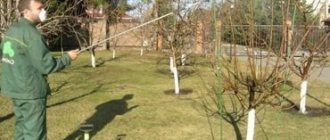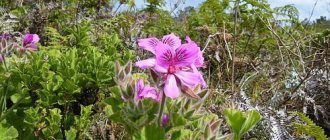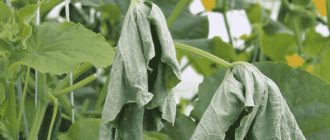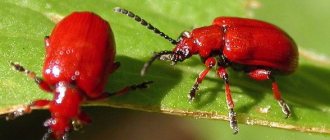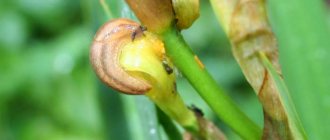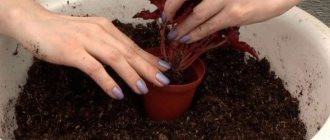Features of diseases in greenhouses and open ground
There are many diseases in cucumbers. In a greenhouse, compared to open ground, they are more common, and their harmfulness increases.
Powdery mildew is very harmful to greenhouse cucumbers , instantly spreading in a closed space. In open ground, the disease is less common and spreads less rapidly. Infection of cucumber plantings and germination of spores occurs during sharp fluctuations in day and night temperatures, prolonged cold spells, and high humidity. On the street, the disease appears 3-4 days after heavy rains.
Downy mildew most often affects cucumbers growing in a greenhouse. The spread of the disease is facilitated by an average daily air temperature of 18-22 degrees, in the presence of dew, fog, and precipitation for 8 hours.
The disease spreads when soil and air temperatures are below 18 degrees and high humidity.
Fusarium develops when air and soil temperatures drop.
Bacteriosis most often spreads in greenhouse conditions. The disease manifests itself at high soil and air humidity. The development of the disease is favored by high humidity and temperature.
Mosaic diseases of cucumbers are common both in greenhouse conditions and in open ground. They appear during sudden changes in air and soil temperatures and thickening of cucumber plantings.
Greenhouse cucumbers are most often affected by white rot. The disease spreads when there is high humidity in the air and soil and insufficient ventilation of the greenhouse. Sudden temperature changes and watering with cold water provoke the disease.
Cladospora blight often occurs in a greenhouse. The main reason for the appearance of the disease is cold weather at night and sprinkling of plants with cold water.
Many diseases persist in the ground for several years, as well as on plant debris and in plant seeds. Replacing the soil in the greenhouse, digging, fertilizing, removing weeds from the beds and treating the soil with protective drugs help prevent the occurrence of diseases.
Pests of cucumbers
Whitefly
Whitefly (aleurodida) is a small white pest that feeds on plant sap.
Pests on plants are identified by white coating, yellowing of leaves and their falling off. Whiteflies settle on the underside of leaves.
Disinfecting the soil in the fall, removing weeds, and freezing greenhouses in winter can help prevent the appearance of pests.
In order to combat the disease, at the initial stage, the plantings are treated with a solution of ash, ammonia, soda, Trichopolum, boric acid, and copper sulfate.
If there are ovaries on the bushes, protective agents such as Verticillin, Fitoverm are used.
In case of severe damage, chemicals are used (Aktellik, Aktara, Confidor).
Spider mite
Spider mites are small pests that weave a thin web around the underside of leaves. When affected, yellow and silvery spots appear on the leaves.
The best prevention of infection is to inspect plants for pests every 2-3 days. The first affected leaves are torn off and burned.
Regular spraying with an infusion of onion and garlic peels, a solution of dispersed or colloidal sulfur (100 grams per 10 liters of water) allows you to eliminate pests and protect plants from their reappearance.
Treatment with ash, boric acid, ammonia, copper sulfate and colloidal silver allows you to avoid pest damage.
About spider mites and other pests of cucumbers: video
Root nematode
The root-knot nematode is a tiny parasitic worm that destroys cucumber vines (most often in a greenhouse), damaging their root system. When infected, plant growth slows down, leaves droop, and galls (thickenings) appear on the roots.
An effective preventative measure is to water the beds with boiling water. After watering, the beds are covered with black film for 3-5 hours. The pest dies after such treatment.
The nematode can be distracted from the beds by planting legumes near the cucumbers.
If the damage occurs during fruiting of cucumbers, biological products are used to treat the affected plantings: Pecilomycin, Metarizin.
To combat non-bearing plants, the following drugs are used: BI-58, Dimethoate, Rogor. It is better not to carry out such treatment during the fruiting period!
melon aphid
The melon aphid is a small dark green, almost black pest that settles in large colonies of cucumber plantings and feeds on plant sap. Aphid larvae are green or yellow.
Aphids are carriers of diseases and, in addition to damaging plants, infect them with harmful viruses and bacteria.
The main signs of aphid infestation are white spots on the back of the leaves, damage to the vines, damage and shedding of flowers and ovaries.
To protect against pests, plants are sprayed with a solution of ash and laundry soap (50 grams of soap, 200 grams of ash per 10 liters of water) or a solution of tobacco (400 grams of dried tobacco, 80 grams of soap per 20 liters of water) or an infusion of onion peels, dandelion, solution ammonia, baking soda, boric acid, Trichopolum.
In case of severe damage, insecticides are used against aphids before the ovaries appear: Iskra, Karbofos, Komandor. If fruits are present, biological preparations Biotlin, Bicol, Fitoverm or a soap solution are used.
Phosphorus-potassium fertilizers (10 grams of potassium chloride, 20 grams of superphosphate per 10 liters of water), administered by spraying, are also effective against aphids. When aphids appear again, treatment is carried out every 6-7 days.
Sprout fly
The sprout fly is a brown, big-eyed fly. Its larvae feed on cucumber embryos, penetrating the germinating seeds. After 2 weeks, pupation and emergence of pests occurs, but by this time the crops are completely destroyed. Deep digging of the soil in the fall, plowing up manure, and removing plant debris helps against the sprout fly.
Tobacco thrips
Tobacco thrips is a small, nimble flying pest. Females lay many eggs in the leaf blades of cucumbers. The lesion appears as small yellowish spots. A scattering of black sticky dots forms on top. Flowers and leaves of cucumbers fall off over time, and the vines become bent.
Effective drugs against this pest: Aktara, Commander, Golden Spark and Fitoverm.
Thrips on cucumbers and the fight against it: video
Black flea beetle
Black (cruciferous) flea beetle is a tiny dark bug. The pest larvae spoil the roots of plants, gnaw through leaves, sucking the juice from them. The leaves turn into a sieve and dry.
The flea overwinters in the top layer of soil. She moves quickly, jumping from leaf to another.
Timely planting of cucumbers avoids the appearance of pests. Early varieties of cucumbers are planted as early as possible, late-ripening ones - later.
Regular weeding of plants helps prevent pests from appearing on cucumbers.
A good protection for cucumber beds is covering material - lutrasil, spunbond, agrospan. It is pulled over the arches and removed when the bushes get stronger and the leaves become strong.
To repel flea beetles, cucumbers in open ground and in greenhouses are alternated with garlic, dill, coriander, and basil. The beds are surrounded by a barrier of marigolds, calendula, wormwood, and nasturtiums.
Ants
Ants are exterminated by chemical agents Muraviin, Raptor, scattering them around the beds and along the perimeter of the greenhouse. You can also use mustard powder, soda, cinnamon, coriander, mint, and tomato stems.
As a preventive measure, before planting cucumbers, the soil is spilled with boiling water.
Medvedka
The mole cricket lives underground, cutting the roots of cucumbers and making nests. If cucumbers fall en masse in a limited area, and passages are visible in the ground, then this is a mole cricket. You can repel the pest by pouring soap solution into the passages. When using chemistry, mole cricket can be eliminated with the help of the drugs Medvetox, Grom, Bazudin.
Pests of cucumbers: video
Spider mites on cucumbers
Mites primarily live on the underside of leaves. They entwine them with a thin web and suck the juice out of them. First, whitish dots form on the leaves, then they become larger, turning into spots. Eventually the leaves turn yellow and dry out.
Spider mites on cucumbers
Control measures
Fight weeds
- Destroy plant debris.
Active measures
Use Kleschevit, Fitoverm, etc. When spraying, pay special attention to the underside of the foliage.
Specifics of pests of open ground and greenhouses
In open ground, pests most often spread from neighboring weeds or when seeds are damaged. In greenhouse conditions, a common cause of damage is poorly treated soil before planting and unfavorable environmental conditions.
The reasons for the appearance of whiteflies are weeds, violation of humidity and temperature conditions, poor air ventilation in the greenhouse and improper nutrition.
Spider mites appear when crop rotation is not observed, plantings are overgrown with weeds, or high air humidity.
Aphids most often overwinter on weeds. The pest reproduces in the spring. First, the aphid feeds on the sap of the weeds, and then moves onto the cucumbers. Pests appear in a greenhouse in the spring, and in open ground - from July to August. The main reasons for the appearance of pests are violations of temperature and humidity, poor air ventilation in the greenhouse, weeds, and insufficient nutrition.
Observance of crop rotation and agricultural technology in general allows you to avoid the appearance of any pests.
Aphids on cucumbers
The shoots become bent and growth slows down. The leaves are wrinkled. Small insects sit in clusters on the tops of shoots and on the undersides of leaves.
aphids on cucumbers
Measures to combat aphids on cucumbers
Prevention
- Pull out the weeds.
- Follow agricultural practices when caring for crops.
Active measures
Spray with insecticides Biotlin, Biotlin BAU, Fitoverm.
Advice from experienced gardeners
When choosing cucumber seeds, disease-resistant varieties are selected.
The best prevention of diseases and pests for cucumbers is alternating crops when planting in the same beds. In the greenhouse, if possible, the top layer of soil is replaced or treated with protective drugs.
Crops are planted next to the plants, repelling pests with their smell and attracting beneficial insects.
When planting cucumbers in a greenhouse, good air circulation is ensured, since in the absence of ventilation, moisture accumulates in closed conditions, provoking the development of fungal diseases.
Watering plants is best done in the evening, this avoids high humidity, the main cause of disease development. For irrigation, use settled, not cold water. You need to water the plants directly under the roots, without touching the leaves.
To protect plants from diseases and pests, the best option is to plant them in a permanent place in the form of mature seedlings. Strong and healthy plants resist illnesses more easily.
Timely feeding of plants guarantees their health and high resistance to disease.
White rot
Sclerotinia (another name for white rot) is a fungal disease that mainly affects greenhouse plantings. The disease affects all above-ground tissues of cucumbers. Initially it appears as a white, “fluffy” coating on the leaves and stems of the bush. Then it spreads to the ovary. The affected areas soften, become watery and darken.
To combat the disease, a set of measures is carried out:
- spray the plantings with copper-based preparations (Bordeaux mixture, Ordan);
- remove diseased shoots to healthy tissue, sprinkle the cut with charcoal;
- fertilize with nitrogen fertilizers;
- Ventilate the greenhouse frequently to reduce humidity levels.
One of the factors contributing to the spread of white rot is dense planting. It is necessary to strictly follow the recommended arrangement of seedlings and remove the lower leaves in time.
